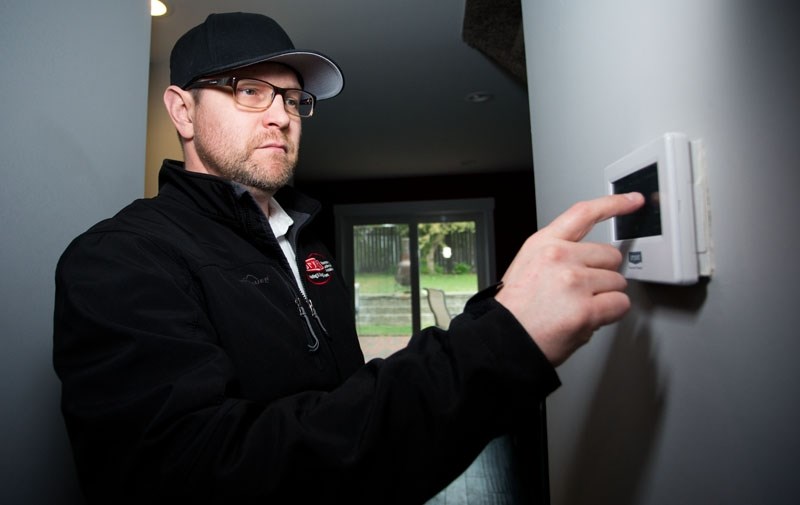I'm not a fan of my air conditioner.
Sure, it works, eventually, but it roars like an angry monster truck whenever it kicks in, furious that it's been disturbed from its rest. It cools the room, but heats the Earth, both in terms of displaced heat and greenhouse gas emissions, and it makes my power bill skyrocket.
So should I replace it with an Energy Star-compliant model? Or is there a better alternative?
Today's Energy Star air conditioners use 30 to 40 per cent less than ones sold 10 to 15 years ago, NRCAN reports.
But cooling accounts for just two per cent of a home's energy use in Canada, NRCAN reports. That's because Canadians usually need heating more than they need cooling. An Edmonton home needs about 2,600 hours of heating a year and just 179 of cooling, suggests NRCAN's Energy Star Calculator.
That makes it tough to recoup your costs on a high-efficiency air conditioner. Dianna Miller, NRCAN's Energy Star program chief, estimates that you'd save about $10 a year with an Energy Star model in Edmonton and prevent at least three kilograms in emissions.
(Miller added that NRCAN's Energy Star Calculator is out of date and currently does not give accurate results for paybacks when it comes to air conditioners.)
It's tough to justify getting a super-high-efficiency air conditioner, said Curtis Crouse, owner of St. Albert's A-1 Heating. You can get an ultra-efficient A/C for $9,000, but a basic one would cost $4,000.
"People would need to believe they are going to run this thing for a lot of the year and that's just not the case in Alberta."
Still, if you've got a huge power bill and your A/C is to blame, an upgrade might be worth it, said Don Curry of Edmonton's Air Aid Mechanical. If you want a high efficiency model, look for one with a seasonable energy efficiency ratio (SEER) of 17 or higher (compared to 13 for entry-level ones) as well as a variable speed compressor (which lets the A/C run at lower speeds than just "full blast").
It's vital for you to ensure your A/C is properly installed and sized if you want to get the most out of it, he noted.
"You can get the highest efficiency unit, but if the contractor doesn't know what he's doing, it's not going to work."
Look elsewhere for savings
There are plenty of better, cheaper ways I could reduce my cooling needs at home.
First, I could make sure my A/C is working properly. If my furnace filter is clogged, for example, the A/C won't get enough airflow, won't cool my home, and will actually freeze solid, Crouse said.
"You end up with a block of ice above your furnace."
He recommends checking your filter once a month and changing it if it looks dirty.
Getting and using a programmable thermostat can reduce your heating needs by 10 to 12 per cent and cooling by about 15 per cent, suggests a 2015 white paper on the Nest thermostat from Nest Labs. (The paper is based on three studies, one by Nest Labs and two independent). This suggests an annual savings of about $131 to $145 – enough to pay for the thermostat in about two years.
Edmonton homes typically use about 121 kWh/yr of electricity for cooling and about 120 gigajoules of natural gas for heat (reports NRCAN and Alberta Energy). If the Nest white paper is right, this suggests that a programmable thermostat could prevent about 630 kg of emissions per year in an Alberta home (11.6 from cooling, 618 from heat).
The U.S. Department of Energy suggests having your thermostat kick in the A/C at 26 C, and to crank back the thermostat four degrees or so eight hours a day (typically when you're not home). Doing so could trim 10 per cent from your heating/cooling needs.
Crouse noted that shade can provide a huge amount of cooling – he hardly has to use his A/C due to his blinds and the trees in his yard.
The U.S. Environmental Protection Agency's research on heat islands found that tree shade can lower peak temperatures on surfaces by up to 25 C, reducing energy use, runoff, and air pollution. A set of highly reflective blinds can cut a home's solar heat gain by 45 per cent, the U.S. Department of Energy reports.
The best way to reduce emissions from your A/C is also the cheapest: avoid using it. By using fans, blinds, a thermostat and open windows, I can make sure that my A/C spends most of the summer fast asleep.
Carbon Tracker
Carbon Tracker
Step: Get and use a programmable thermostat.
Difficulty: Easy.
Cost: Depends on the model, but a Nest is $330.
Payback Period: About two years.
Carbon Saved: 630 kg/yr. NOTE: payback and carbon will vary widely depending on how you use your thermostat.
The Carbon Challenge
The Carbon Challenge will profile different ways you can shrink your carbon footprint and (usually) save money every second week. <br />Got a carbon question? Drop me a line at [email protected].




